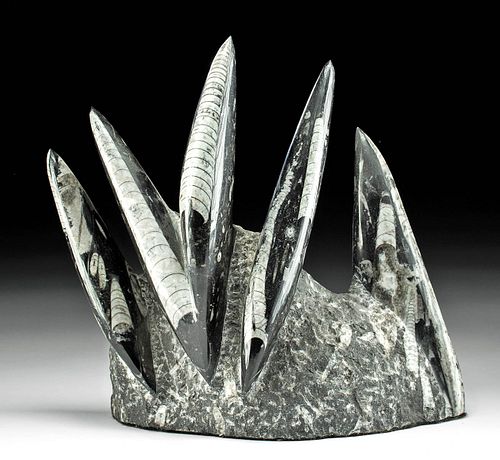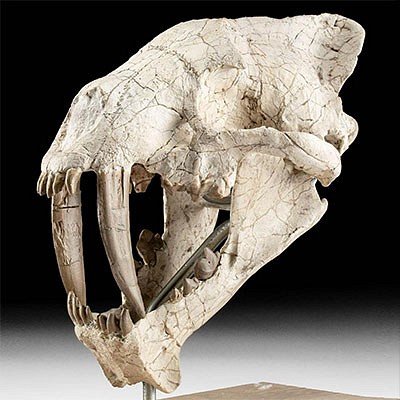Large Fossilized Orthoceras Geisenoceras in Matrix
Lot 11
About Seller
Artemis Fine Arts
686 S Taylor Ave, Ste 106
Louisville, CO 80027
United States
Selling antiquities, ancient and ethnographic art online since 1993, Artemis Gallery specializes in Classical Antiquities (Egyptian, Greek, Roman, Near Eastern), Asian, Pre-Columbian, African / Tribal / Oceanographic art. Our extensive inventory includes pottery, stone, metal, wood, glass and textil...Read more
Estimate:
$400 - $600
Absentee vs Live bid
Two ways to bid:
- Leave a max absentee bid and the platform will bid on your behalf up to your maximum bid during the live auction.
- Bid live during the auction and your bids will be submitted real-time to the auctioneer.
Bid Increments
| Price | Bid Increment |
|---|---|
| $0 | $25 |
| $300 | $50 |
| $1,000 | $100 |
| $2,000 | $250 |
| $5,000 | $500 |
| $10,000 | $1,000 |
| $20,000 | $2,500 |
| $50,000 | $5,000 |
| $100,000 | $10,000 |
| $200,000 | $20,000 |
About Auction
By Artemis Fine Arts
Jul 13, 2021
Set Reminder
2021-07-13 12:00:00
2021-07-13 12:00:00
America/New_York
Bidsquare
Bidsquare : Fauna, Flora, Stones & Bones
https://www.bidsquare.com/auctions/artemis-gallery/fauna-flora-stones-bones-7214
Join us for a very special summer auction featuring fabulous fossils, rocks, and minerals, plus art depicting flora and fauna from antiquity to present day. This is one you won't want to miss! Artemis Fine Arts info@artemisgallery.com
Join us for a very special summer auction featuring fabulous fossils, rocks, and minerals, plus art depicting flora and fauna from antiquity to present day. This is one you won't want to miss! Artemis Fine Arts info@artemisgallery.com
- Lot Description
Ancient Seas, Morocco, Tindouf Basin, Devonian Period, ca. 419.2 to 358.9 million years ago. A stone matrix filled with wonderful Orthoceras fossils of the Geisenoceras genus that were once part of the prehistoric ocean floor over 400 million years ago! As these forms of prehistoric squid were covered in ocean sediments prior to fossilization, most of these creatures faced the same relative position, having been lined up by currents on the sea floor prior to being buried. The Orthoceras bodies were elongated with conical shells that protected their soft tentacles and a beak; their fleshy bodies decayed long before the fossilization process could occur. These fossilized shells are exposed and prepared with their pointed forms rising from the matrix and given a high polish to better view the creatures and give contrast against the rest of the stone. Each polished spire contains at least one full shell, and some have partial pieces as well. The high relief as well as dramatic texture and details make this almost an abstract modernist sculpture! The bottom has been cut to form a flat, stable base and these fossils could make an interesting centerpiece on a table or mantle. Size: 10.5" L x 5" W x 11.125" H (26.7 cm x 12.7 cm x 28.3 cm)
Prehistoric 'straight' cephalopods include straight ammonoids called orthoceras. Cephalopod evolution began during the Late Cambrian Period. Some of these creatures evolved into semi-coiled forms, eventually giving rise to coiled cephalopods like ammonites and nautili. Straight cephalopods were among the most advanced invertebrates of their time, with eyes, jaws, and a sophisticated nervous system. These creatures were predators that swam freely using a jet propulsion system by squirting water from their bodies. They had tentacles and ink sacs, much like present-day squid. Except for belemnites, cephalopods had external shells with hollow internal chambers separated by walls called septa. A tube called the siphuncle, connected the body with the chambers allowing the animal to fill them with water or air, changing its buoyancy in order to rise or drop in the ocean. Only the last and largest chamber was occupied by the living animal. Belemnites were different in that they had internal shells called "guards" which were covered with the soft, muscular tissues of their bodies. These shells were also chambered but much less complex than the straight varieties of nautiloids and ammonoids.
Provenance: ex-Stein collection, Bloomfield Hills, Michigan, USA, acquired prior to 2010
All items legal to buy/sell under U.S. Statute covering cultural patrimony Code 2600, CHAPTER 14, and are guaranteed to be as described or your money back.
A Certificate of Authenticity will accompany all winning bids.
PLEASE NOTE: Due to recent increases of shipments being seized by Australian & German customs (even for items with pre-UNESCO provenance), we will no longer ship most antiquities and ancient Chinese art to Australia & Germany. For categories of items that are acceptable to ship to Australia, please contact us directly or work with your local customs brokerage firm.
#164312Nicks and chips to tips of polished points. One tip is reattached, but break line is nearly indiscernible and well done. Polished areas. Felt pad added to base for stability and a printed label is attached.Condition
- Shipping Info
-
All shipping is handled in-house for your convenience. Your invoice from Artemis Gallery will include shipping calculation instructions. If in doubt, please inquire BEFORE bidding for estimated shipping costs for individual items.
-
- Buyer's Premium



 EUR
EUR CAD
CAD AUD
AUD GBP
GBP MXN
MXN HKD
HKD CNY
CNY MYR
MYR SEK
SEK SGD
SGD CHF
CHF THB
THB













